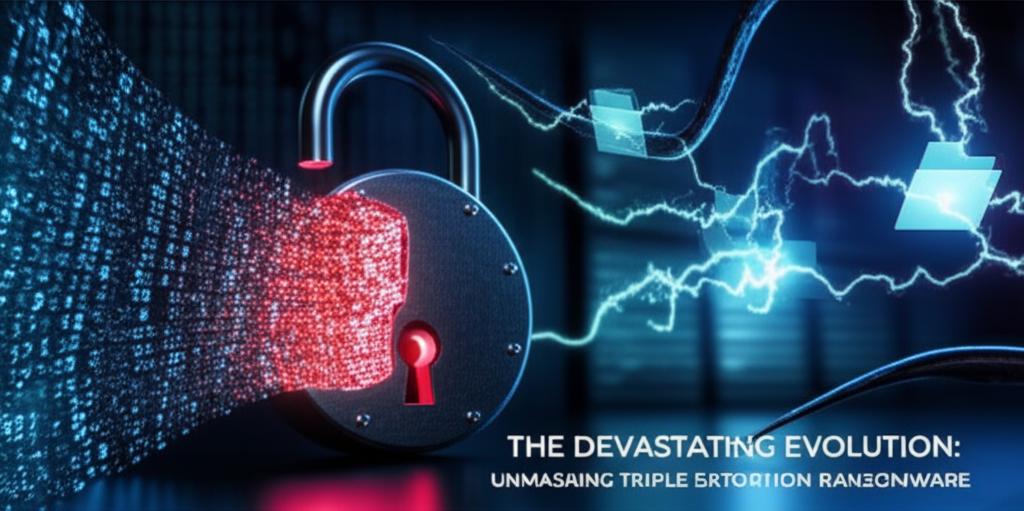The Devastating Evolution: Unmasking Triple Extortion Ransomware
In the evolving landscape of cyber threats, ransomware has long been a notorious adversary. However, a more insidious and multi-layered attack method has emerged: Triple Extortion Ransomware. This sophisticated approach goes far beyond simply encrypting data, leveraging multiple points of pressure to maximize the likelihood of payment and inflict maximum damage on targeted organizations.
What is Triple Extortion Ransomware?
Unlike traditional ransomware, which primarily focuses on encrypting a victim’s data and demanding payment for the decryption key, Triple Extortion Ransomware introduces at least two additional layers of pressure. It’s a calculated escalation of tactics designed to cripple an organization through various means until the ransom is paid.
The Three Pillars of Triple Extortion
Understanding the components of Triple Extortion Ransomware is crucial for preparing a robust defense:
- Data Encryption and Ransom (First Extortion): This is the classic ransomware attack. Cybercriminals encrypt an organization’s critical data and systems, rendering them inaccessible. A ransom, typically in cryptocurrency, is demanded for the decryption key.
- Data Exfiltration and Public Disclosure (Second Extortion): Before or during the encryption process, threat actors steal sensitive data from the victim’s network. They then threaten to publish this data on leak sites, dark web forums, or send it directly to competitors or regulatory bodies, creating immense reputational, legal, and financial pressure.
- DDoS Attacks and Operational Disruption (Third Extortion): The final layer involves launching Distributed Denial of Service (DDoS) attacks against the victim’s website, online services, or critical infrastructure. This disrupts business operations, leads to significant downtime, and impacts customer trust, adding another powerful incentive for the victim to pay the ransom.
Why is Triple Extortion Ransomware So Dangerous?
The danger of Triple Extortion Ransomware lies in its multifaceted approach to coercion. An organization might have robust backups to recover encrypted data, mitigating the first layer of extortion. However, the threat of sensitive data being exposed (second extortion) or critical online services being knocked offline (third extortion) can still force their hand. This comprehensive pressure campaign makes recovery incredibly challenging and increases the likelihood of a payout, even for well-prepared entities.
Moreover, the rise of Triple Extortion Ransomware signifies a shift in attacker mentality, moving from opportunistic encryption to a strategic, sustained assault on an organization’s entire digital footprint and public image. The damage from a Triple Extortion Ransomware attack can extend far beyond financial loss, impacting customer trust, brand reputation, and long-term operational viability.
How to Protect Against Triple Extortion Ransomware
Mitigating the risk of Triple Extortion Ransomware requires a multi-layered, proactive cybersecurity strategy:
- Robust Backup and Recovery: Implement immutable, off-site, and offline backups to quickly restore data without paying ransom for encryption.
- Advanced Endpoint Protection: Deploy next-generation antivirus (NGAV) and Endpoint Detection and Response (EDR) solutions to detect and prevent malicious activity.
- Network Segmentation: Segment your network to limit lateral movement of attackers and contain breaches.
- Data Loss Prevention (DLP): Utilize DLP tools to monitor and prevent unauthorized exfiltration of sensitive data.
- DDoS Mitigation: Implement DDoS protection services to safeguard online services against volumetric attacks.
- Security Awareness Training: Educate employees about phishing, social engineering, and safe browsing practices, as human error remains a primary vector for initial compromise.
- Incident Response Plan: Develop and regularly test a comprehensive incident response plan specifically for ransomware and data breach scenarios.
- Patch Management: Keep all software and systems updated to patch known vulnerabilities that attackers might exploit.
The Future of Cyber Threats
As cybercriminals continue to innovate, tactics like Triple Extortion Ransomware will become more commonplace. Staying ahead requires constant vigilance, robust security investments, and a proactive posture. Organizations must recognize the expanded scope of these attacks and build defenses that address all three layers of extortion to protect their assets, reputation, and operations from this devastating threat.







